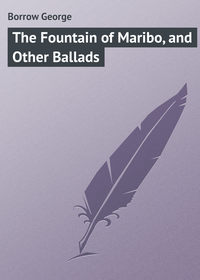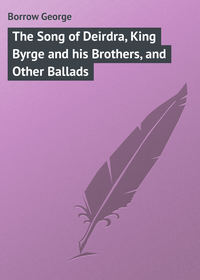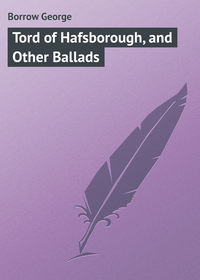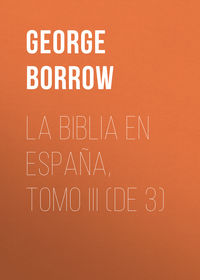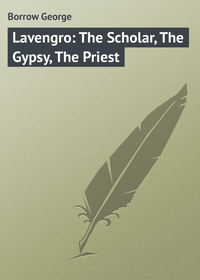 полная версия
полная версияThe Bible in Spain. Volume 1 of 2
From Estremoz to Elvas the distance is six leagues. I started at nine next morning; the first part of the way lay through an inclosed country, but we soon emerged upon wild bleak downs, over which the wind, which still pursued us, howled most mournfully. We met no one on the route; and the scene was desolate in the extreme; the heaven was of a dark grey, through which no glimpse of the sun was to be perceived. Before us, at a great distance, on an elevated ground, rose a tower – the only object which broke the monotony of the waste. In about two hours from the time when we first discovered it, we reached a fountain, at the foot of the hill on which it stood; the water, which gushed into a long stone trough, was beautifully clear and transparent, and we stopped here to water the animals.
Having dismounted, I left the guide, and proceeded to ascend the hill on which the tower stood. Though the ascent was very gentle, I did not accomplish it without difficulty; the ground was covered with sharp stones, which, in two or three instances, cut through my boots and wounded my feet; and the distance was much greater than I had expected. I at last arrived at the ruin, for such it was. I found it had been one of those watch-towers or small fortresses called in Portuguese atalaias; it was square, and surrounded by a wall, broken down in many places. The tower itself had no door, the lower part being of solid stonework; but on one side were crevices at intervals between the stones, for the purpose of placing the feet, and up this rude staircase I climbed to a small apartment, about five feet square, from which the top had fallen. It commanded an extensive view from all sides, and had evidently been built for the accommodation of those whose business it was to keep watch on the frontier, and at the appearance of an enemy to alarm the country by signals – probably by a fire. Resolute men might have defended themselves in this little fastness against many assailants, who must have been completely exposed to their arrows or musketry in the ascent.
Being about to leave the place, I heard a strange cry behind a part of the wall which I had not visited, and hastening thither, I found a miserable object in rags, seated upon a stone. It was a maniac – a man about thirty years of age, and I believe deaf and dumb; there he sat, gibbering and mowing, and distorting his wild features into various dreadful appearances. There wanted nothing but this object to render the scene complete; banditti amongst such melancholy desolation would have been by no means so much in keeping. But the maniac, on his stone, in the rear of the wind-beaten ruin, overlooking the blasted heath, above which scowled the leaden heaven, presented such a picture of gloom and misery as I believe neither painter nor poet ever conceived in the saddest of their musings. This is not the first instance in which it has been my lot to verify the wisdom of the saying, that truth is sometimes wilder than fiction.
I remounted my mule, and proceeded till, on the top of another hill, my guide suddenly exclaimed, “There is Elvas!” I looked in the direction in which he pointed, and beheld a town perched on the top of a lofty hill. On the other side of a deep valley towards the left rose another hill, much higher, on the top of which is the celebrated fort of Elvas, believed to be the strongest place in Portugal. Through the opening between the fort and the town, but in the background and far in Spain, I discerned the misty sides and cloudy head of a stately mountain, which I afterwards learned was Albuquerque, one of the loftiest of Estremadura.
We now got into a cultivated country, and following the road, which wound amongst hedgerows, we arrived at a place where the ground began gradually to shelve down. Here, on the right, was the commencement of an aqueduct, by means of which the town on the opposite hill was supplied; it was at this point scarcely two feet in altitude, but, as we descended, it became higher and higher, and its proportions more colossal.
Near the bottom of the valley it took a turn to the left, bestriding the road with one of its arches. I looked up, after passing under it; the water must have been flowing near a hundred feet above my head, and I was filled with wonder at the immensity of the structure which conveyed it. There was, however, one feature which was no slight drawback to its pretensions to grandeur and magnificence: the water was supported not by gigantic single arches, like those of the aqueduct of Lisbon, which stalk over the valley like legs of Titans, but by three layers of arches, which, like three distinct aqueducts, rise above each other. The expense and labour necessary for the erection of such a structure must have been enormous; and when we reflect with what comparative ease modern art would confer the same advantage, we cannot help congratulating ourselves that we live in times when it is not necessary to exhaust the wealth of a province to supply a town on a hill with one of the first necessaries of existence.
CHAPTER VIII
Elvas – Extraordinary Longevity – The English Nation – Portuguese Ingratitude – Illiberality – Fortifications – Spanish Beggar – Badajoz – The Custom-House.
Arrived at the gate of Elvas, an officer came out of a kind of guard-house, and, having asked me some questions, despatched a soldier with me to the police-office, that my passport might be visé, as upon the frontier they are much more particular with respect to passports than in other parts. This matter having been settled, I entered an hostelry near the same gate, which had been recommended to me by my host at Vendas Novas, and which was kept by a person of the name of Jozé Rosado. It was the best in the town, though, for convenience and accommodation, inferior to a hedge alehouse in England. The cold still pursued me, and I was glad to take refuge in an inner kitchen, which, when the door was not open, was only lighted by a fire burning somewhat dimly on the hearth. An elderly female sat beside it in her chair, telling her beads: there was something singular and extraordinary in her look, as well as I could discern by the imperfect light of the apartment. I put a few unimportant questions to her, to which she replied, but seemed to be afflicted to a slight degree with deafness. Her hair was becoming grey, and I said that I believed she was older than myself, but that I was confident she had less snow on her head.
“How old may you be, cavalier?” said she, giving me that title which in Spain is generally used when an extraordinary degree of respect is wished to be exhibited. I answered that I was near thirty. “Then,” said she, “you were right in supposing that I am older than yourself; I am older than your mother, or your mother’s mother: it is more than a hundred years since I was a girl, and sported with the daughters of the town on the hillside.” “In that case,” said I, “you doubtless remember the earthquake.” “Yes,” she replied, “if there is any occurrence in my life that I remember, it is that: I was in the church of Elvas at the moment, hearing the Mass of the king, and the priest fell on the ground, and let fall the Host from his hands. I shall never forget how the earth shook; it made us all sick; and the houses and walls reeled like drunkards. Since that happened I have seen fourscore years pass by me, yet I was older then than you are now.”
I looked with wonder at this surprising female, and could scarcely believe her words. I was, however, assured that she was in fact upwards of a hundred and ten years of age, and was considered the oldest person in Portugal. She still retained the use of her faculties in as full a degree as the generality of people who have scarcely attained the half of her age. She was related to the people of the house.
As the night advanced, several persons entered for the purpose of enjoying the comfort of the fire, and for the sake of conversation, for the house was a kind of news-room, where the principal speaker was the host, a man of some shrewdness and experience, who had served as a soldier in the British army. Amongst others was the officer who commanded at the gate. After a few observations, this gentleman, who was a good-looking young man of five and twenty, began to burst forth in violent declamation against the English nation and government, who, he said, had at all times proved themselves selfish and deceitful, but that their present conduct in respect to Spain was particularly infamous, for though it was in their power to put an end to the war at once, by sending a large army thither, they preferred sending a handful of troops, in order that the war might be prolonged, for no other reason than that it was of advantage to them. Having paid him an ironical compliment for his politeness and urbanity, I asked whether he reckoned amongst the selfish actions of the English government and nation, their having expended hundreds of millions of pounds sterling, and an ocean of precious blood, in fighting the battles of Spain and Portugal against Napoleon. “Surely,” said I, “the fort of Elvas above our heads, and still more the castle of Badajoz66 over the water, speak volumes respecting English selfishness, and must, every time you view them, confirm you in the opinion which you have just expressed. And then, with respect to the present combat in Spain, the gratitude which that country evinced to England after the French, by means of English armies, had been expelled, – gratitude evinced by discouraging the trade of England on all occasions, and by offering up masses in thanksgiving when the English heretics quitted the Spanish shores, ought now to induce England to exhaust and ruin herself, for the sake of hunting Don Carlos out of his mountains. In deference to your superior judgment,” continued I to the officer, “I will endeavour to believe that it would be for the advantage of England were the war prolonged for an indefinite period; nevertheless, you would do me a particular favour by explaining by what process in chemistry blood shed in Spain will find its way into the English treasury in the shape of gold.”
As he was not ready with his answer, I took up a plate of fruit which stood on the table beside me, and said, “What do you call these fruits?” “Pomegranates and bolotas,” he replied. “Right,” said I, “a homebred Englishman could not have given me that answer; yet he is as much acquainted with pomegranates and bolotas as your lordship is with the line of conduct which it is incumbent upon England to pursue in her foreign and domestic policy.”
This answer of mine, I confess, was not that of a Christian, and proved to me how much of the leaven of the ancient man still pervaded me; yet I must be permitted to add that I believe no other provocation would have elicited from me a reply so full of angry feeling: but I could not command myself when I heard my own glorious land traduced in this unmerited manner. By whom? A Portuguese! A native of a country which has been twice liberated from horrid and detestable thraldom by the hands of Englishmen. But for Wellington and his heroes, Portugal would have been French at this day; but for Napier and his marines, Miguel would now be lording it in Lisbon. To return, however, to the officer: every one laughed at him, and he presently went away.
The next day I became acquainted with a respectable tradesman, of the name of Almeida, a man of talent, though rather rough in his manners. He expressed great abhorrence of the papal system, which had so long spread a darkness, like that of death, over his unfortunate country; and I had no sooner informed him that I had brought with me a certain quantity of Testaments, which it was my intention to leave for sale at Elvas, than he expressed a great desire to undertake the charge, and said that he would do the utmost in his power to procure a sale for them amongst his numerous customers. Upon showing him a copy, I remarked, “Your name is upon the title-page;” the Portuguese version of the Holy Scriptures,67 circulated by the Bible Society, having been executed by a Protestant, of the name of Almeida, and first published in the year 1712; whereupon he smiled, and observed that he esteemed it an honour to be connected in name at least with such a man. He scoffed at the idea of receiving any remuneration, and assured me that the feeling of being permitted to co-operate in so holy and useful a cause as the circulation of the Scriptures was quite a sufficient reward.
After having accomplished this matter, I proceeded to survey the environs of the place, and strolled up the hill to the fort on the north side of the town. The lower part of the hill is planted with azinheiras, which give it a picturesque appearance, and at the bottom is a small brook, which I crossed by means of stepping-stones. Arrived at the gate of the fort, I was stopped by the sentry, who, however, civilly told me that if I sent in my name to the commanding officer, he would make no objection to my visiting the interior. I accordingly sent in my card by a soldier who was lounging about, and, sitting down on a stone, waited his return. He presently appeared, and inquired whether I was an Englishman; to which having replied in the affirmative, he said, “In that case, sir, you cannot enter; indeed, it is not the custom to permit any foreigners to visit the fort.” I answered that it was perfectly indifferent to me whether I visited it or not; and, having taken a survey of Badajoz from the eastern side of the hill, descended by the way I came.
This is one of the beneficial results of protecting a nation, and squandering blood and treasure in its defence. The English, who have never been at war with Portugal, who have fought for its independence on land and sea, and always with success, who have forced themselves, by a treaty of commerce,68 to drink its coarse and filthy wines, which no other nation cares to taste, are the most unpopular people who visit Portugal. The French have ravaged the country with fire and sword, and shed the blood of its sons like water; the French buy not its fruits, and loathe its wines, yet there is no bad spirit in Portugal towards the French. The reason of this is no mystery; it is the nature not of the Portuguese only, but of corrupt and unregenerate man, to dislike his benefactors, who, by conferring benefits upon him, mortify in the most generous manner his miserable vanity.
There is no country in which the English are so popular as in France;69 but, though the French have been frequently roughly handled by the English, and have seen their capital occupied by an English army, they have never been subjected to the supposed ignominy of receiving assistance from them.
The fortifications of Elvas are models of their kind, and, at the first view, it would seem that the town, if well garrisoned, might bid defiance to any hostile power; but it has its weak point: the western side is commanded by a hill, at the distance of half a mile, from which an experienced general would cannonade it, and probably with success. It is the last town in this part of Portugal, the distance to the Spanish frontier being barely two leagues. It was evidently built as a rival to Badajoz, upon which it looks down from its height across a sandy plain and over the sullen waters of the Guadiana; but, though a strong town, it can scarcely be called a defence to the frontier, which is open on all sides, so that there would not be the slightest necessity for an invading army to approach within a dozen leagues of its walls, should it be disposed to avoid them. Its fortifications are so extensive that ten thousand men at least would be required to man them, who, in the event of an invasion, might be far better employed in meeting the enemy in the open field. The French, during their occupation of Portugal, kept a small force in this place, who, at the approach of the British, retreated to the fort, where they shortly after capitulated.
Having nothing farther to detain me at Elvas, I proceeded to cross the frontier into Spain. My idiot guide was on his way back to Aldea Gallega; and, on the fifth of January, I mounted a sorry mule, without bridle or stirrups, which I guided by a species of halter, and followed by a lad who was to attend me on another, I spurred down the hill of Elvas to the plain, eager to arrive in old chivalrous, romantic Spain. But I soon found that I had no need to quicken the beast which bore me, for, though covered with sores, wall-eyed, and with a kind of halt in its gait, it cantered along like the wind.
In little more than half an hour we arrived at a brook, whose waters ran vigorously between steep banks. A man who was standing on the side directed me to the ford in the squeaking dialect of Portugal; but whilst I was yet splashing through the water, a voice from the other bank hailed me, in the magnificent language of Spain, in this guise: “O! Señor Caballero, que me dé usted una limosna por amor de Dios, una limosnita para que yo me compre un traguillo de vino tinto.”70 In a moment I was on Spanish ground, as the brook, which is called Acaia, is the boundary here of the two kingdoms, and, having flung the beggar a small piece of silver, I cried in ecstasy, “Santiago y cierra España!”71 and scoured on my way with more speed than before, paying, as Gil Blas says, little heed to the torrent of blessings which the mendicant poured forth in my rear:72 yet never was charity more unwisely bestowed, for I was subsequently informed that the fellow was a confirmed drunkard, who took his station every morning at the ford, where he remained the whole day for the purpose of extorting money from the passengers, which he regularly spent every night in the wine-shops of Badajoz. To those who gave him money he returned blessings, and to those who refused, curses; being equally skilled and fluent in the use of either.
Badajoz was now in view, at the distance of little more than half a league. We soon took a turn to the left, towards a bridge of many arches across the Guadiana, which, though so famed in song and ballad, is a very unpicturesque stream, shallow and sluggish, though tolerably wide; its banks were white with linen which the washerwomen had spread out to dry in the sun, which was shining brightly; I heard their singing at a great distance, and the theme seemed to be the praises of the river where they were toiling, for as I approached I could distinguish “Guadiana, Guadiana,” which reverberated far and wide, pronounced by the clear and strong voices in chorus of many a dark-cheeked maid and matron. I thought there was some analogy between their employment and my own: I was about to tan my northern complexion by exposing myself to the hot sun of Spain, in the humble hope of being able to cleanse some of the foul stains of Popery from the minds of its children, with whom I had little acquaintance; whilst they were bronzing themselves on the banks of the river in order to make white the garments of strangers. The words of an Eastern poet returned forcibly to my mind —
“I’ll weary myself each night and each day,To aid my unfortunate brothers;As the laundress tans her own face in the ray,To cleanse the garments of others.”Having crossed the bridge,73 we arrived at the northern gate, when out rushed from a species of sentry-box a fellow wearing on his head a high-peaked Andalusian hat, with his figure wrapped up in one of these immense cloaks74 so well known to those who have travelled in Spain, and which none but a Spaniard can wear in a becoming manner. Without saying a word, he laid hold of the halter of the mule, and began to lead it through the gate up a dirty street, crowded with long-cloaked people like himself. I asked him what he meant, but he deigned not to return an answer; the boy, however, who waited upon me, said that it was one of the gate-keepers, and that he was conducting us to the custom-house or Alfandega, where the baggage would be examined. Having arrived there, the fellow, who still maintained a dogged silence, began to pull the trunks off the sumpter-mule, and commenced uncording them. I was about to give him a severe reproof for his brutality; but before I could open my mouth a stout elderly personage appeared at the door, who I soon found was the principal officer. He looked at me for a moment, and then asked me, in the English language, if I was an Englishman. On my replying in the affirmative, he demanded of the fellow how he dared to have the insolence to touch the baggage without orders, and sternly bade him cord up the trunks again and place them on the mule, which he performed without uttering a word. The gentleman then asked what the trunks contained: I answered clothes and linen; when he begged pardon for the insolence of the subordinate, and informed me that I was at liberty to proceed where I thought proper. I thanked him for his exceeding politeness; and, under guidance of the boy, made the best of my way to the Inn of the Three Nations,75 to which I had been recommended at Elvas.
CHAPTER IX
Badajoz – Antonio the Gypsy – Antonio’s Proposal – The Proposal accepted – Gypsy Breakfast – Departure from Badajoz – The Gypsy Donkey – Merida – The Ruined Wall – The Crone – The Land of the Moor – The Black Men – Life in the Desert – The Supper.
I was now at Badajoz in Spain, a country which for the next four years was destined to be the scene of my labours: but I will not anticipate. The neighbourhood of Badajoz did not prepossess me much in favour of the country which I had just entered. It consists chiefly of brown moors, which bear little but a species of brushwood, called in Spanish carrasco; blue mountains are, however, seen towering up in the far distance, which relieve the scene from the monotony which would otherwise pervade it.
It was at this town of Badajoz, the capital of Estremadura, that I first fell in with those singular people, the Zincali, Gitanos, or Spanish gypsies. It was here I met with the wild Paco,76 the man with the withered arm, who wielded the cachas77 with his left hand; his shrewd wife, Antonia, skilled in hokkano baro, or the great trick78; the fierce gypsy, Antonio Lopez, their father-in-law; and many other almost equally singular individuals of the Errate, or gypsy blood. It was here that I first preached the gospel to the gypsy people, and commenced that translation of the New Testament in the Spanish gypsy tongue, a portion of which I subsequently printed at Madrid.
After a stay of three weeks at Badajoz, I prepared to depart for Madrid: late one afternoon, as I was arranging my scanty baggage, the gypsy Antonio entered my apartment, dressed in his zamarra and high-peaked Andalusian hat.
Antonio. – Good evening, brother; they tell me that on the callicaste you intend to set out for Madrilati.
Myself. – Such is my intention; I can stay here no longer.
Antonio. – The way is far to Madrilati, there are, moreover, wars in the land, and many chories walk about; are you not afraid to journey?
Myself. – I have no fears; every man must accomplish his destiny: what befalls my body or soul was written in a gabicote a thousand years before the foundation of the world.
Antonio. – I have no fears myself, brother; the dark night is the same to me as the fair day, and the wild carrascal as the market-place or the chardí; I have got the bar lachí in my bosom, the precious stone to which sticks the needle.79
Myself. – You mean the loadstone, I suppose. Do you believe that a lifeless stone can preserve you from the dangers which occasionally threaten your life?
Antonio. – Brother, I am fifty years old, and you see me standing before you in life and strength; how could that be unless the bar lachí had power? I have been soldier and contrabandista, and I have likewise slain and robbed the Busné. The bullets of the Gabiné and of the jara canallis have hissed about my ears without injuring me, for I carried the bar lachí. I have twenty times done that which by Busné law should have brought me to the filimicha, yet my neck has never yet been squeezed by the cold garrote. Brother, I trust in the bar lachí, like the Caloré of old: were I in the midst of the gulph of Bombardó without a plank to float upon, I should feel no fear; for if I carried the precious stone, it would bring me safe to shore. The bar lachí has power, brother.



